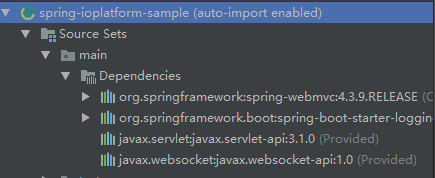小编给大家分享一下Spring IO Platform的示例分析,相信大部分人都还不怎么了解,因此分享这篇文章给大家参考一下,希望大家阅读完这篇文章后大有收获,下面让我们一起去了解一下吧!
Spring IO Platform框架简单来说就是一个版本号兼容系统,它将常用第三方类库的兼容的版本组织起来。只要我们在项目中引用了Spring IO Platform,就不需要为这些第三方类库设置版本号了,Spring IO Platform会自动帮我们设置所有兼容的版本号。
引入类库
使用Maven
使用Maven的话,在pom.xml中修改为类似这样的。
<?xml version="1.0" encoding="UTF-8"?>
<project xmlns="http://maven.apache.org/POM/4.0.0"
xmlns:xsi="http://www.w3.org/2001/XMLSchema-instance"
xsi:schemaLocation="http://maven.apache.org/POM/4.0.0 http://maven.apache.org/xsd/maven-4.0.0.xsd">
<modelVersion>4.0.0</modelVersion>
<groupId>com.example</groupId>
<artifactId>your-application</artifactId>
<version>1.0.0-SNAPSHOT</version>
<!-- 添加以下一段-->
<dependencyManagement>
<dependencies>
<dependency>
<groupId>io.spring.platform</groupId>
<artifactId>platform-bom</artifactId>
<version>Brussels-SR3</version>
<type>pom</type>
<scope>import</scope>
</dependency>
</dependencies>
</dependencyManagement>
<!-- Dependency declarations -->
</project>或者将设置Spring IO Platform为父项目也行
<?xml version="1.0" encoding="UTF-8"?>
<project xmlns="http://maven.apache.org/POM/4.0.0"
xmlns:xsi="http://www.w3.org/2001/XMLSchema-instance"
xsi:schemaLocation="http://maven.apache.org/POM/4.0.0 http://maven.apache.org/xsd/maven-4.0.0.xsd">
<modelVersion>4.0.0</modelVersion>
<groupId>com.example</groupId>
<artifactId>your-application</artifactId>
<version>1.0.0-SNAPSHOT</version>
<parent>
<groupId>io.spring.platform</groupId>
<artifactId>platform-bom</artifactId>
<version>Brussels-SR3</version>
<relativePath/>
</parent>
<!-- Dependency declarations -->
</project>设置完成后,以后添加依赖项就不需要指定版本好了。可以像下面这样添加依赖。
<dependencies>
<dependency>
<groupId>org.springframework</groupId>
<artifactId>spring-core</artifactId>
<!-- 没有版本号 -->
</dependency>
</dependencies>使用Gradle
如果用Gradle的话,就稍微复杂一点了。因为Gradle没有dependencyManagement这么一个功能,所以还需要额外的插件。总之,将build.gradle文件修改为类似这样即可。
buildscript {
repositories {
jcenter()
}
dependencies {
classpath 'io.spring.gradle:dependency-management-plugin:1.0.0.RELEASE'
}
}
apply plugin: 'io.spring.dependency-management'
repositories {
mavenCentral()
}
dependencyManagement {
imports {
mavenBom 'io.spring.platform:platform-bom:Brussels-SR3'
}
}然后,声明依赖就不需要版本号了。
dependencies {
compile 'org.springframework:spring-core'
}覆盖版本号
有时候可能需要覆盖Spring IO Platform中的版本号,改为使用我们自己指定的版本号。如果使用Maven的话,在pom.xml文件的properties节点中修改版本号。
<properties>
<foo.version>1.1.0.RELEASE</foo.version>
</properties>如果使用Gradle的话,在build.gradle中添加ext属性即可。
ext['foo.version'] = '1.1.0.RELEASE'或者
ext {
foo.version = '1.1.0.RELEASE'
}也可以在gradle.properties文件中设置。
foo.version=1.1.0.RELEASE已知问题
由于谷歌Guava类库的广泛使用,引用不同的项目时可能存在不兼容情况。这时候需要我们手动指定合适的版本号以保证项目能够正常运行。
如果想详细了解Spring IO Platform的版本号,可以查看官方文档附录。
示例程序
其实这篇文章到这里就可以结束了,因为Spring IO Platform实际上确实也没有多少东西要讲。
这是我的一个小小例子,用Spring IO Platform和Gradle构建的一个Spring MVC程序。下面是对应的build.gradle文件。可以看到由于使用了Spring IO Platform,所以这里的依赖项全部没有指定版本号。
group 'yitian.study'
version '1.0-SNAPSHOT'
buildscript {
repositories {
jcenter()
}
dependencies {
classpath 'io.spring.gradle:dependency-management-plugin:1.0.0.RELEASE'
}
}
apply plugin: 'java'
apply plugin: 'war'
apply from: 'https://raw.github.com/akhikhl/gretty/master/pluginScripts/gretty.plugin'
apply plugin: 'io.spring.dependency-management'
sourceCompatibility = 1.8
repositories {
mavenCentral()
jcenter()
}
dependencies {
testCompile group: 'junit', name: 'junit'
compile 'org.springframework:spring-webmvc'
compile group: 'org.springframework.boot', name: 'spring-boot-starter-logging'
}
dependencyManagement {
imports {
mavenBom 'io.spring.platform:platform-bom:Brussels-SR3'
}
}从IDE的提示可以看到,所有版本号都由Spring IO Platform正确处理了。

以上是“Spring IO Platform的示例分析”这篇文章的所有内容,感谢各位的阅读!相信大家都有了一定的了解,希望分享的内容对大家有所帮助,如果还想学习更多知识,欢迎关注亿速云行业资讯频道!
亿速云「云服务器」,即开即用、新一代英特尔至强铂金CPU、三副本存储NVMe SSD云盘,价格低至29元/月。点击查看>>
免责声明:本站发布的内容(图片、视频和文字)以原创、转载和分享为主,文章观点不代表本网站立场,如果涉及侵权请联系站长邮箱:is@yisu.com进行举报,并提供相关证据,一经查实,将立刻删除涉嫌侵权内容。